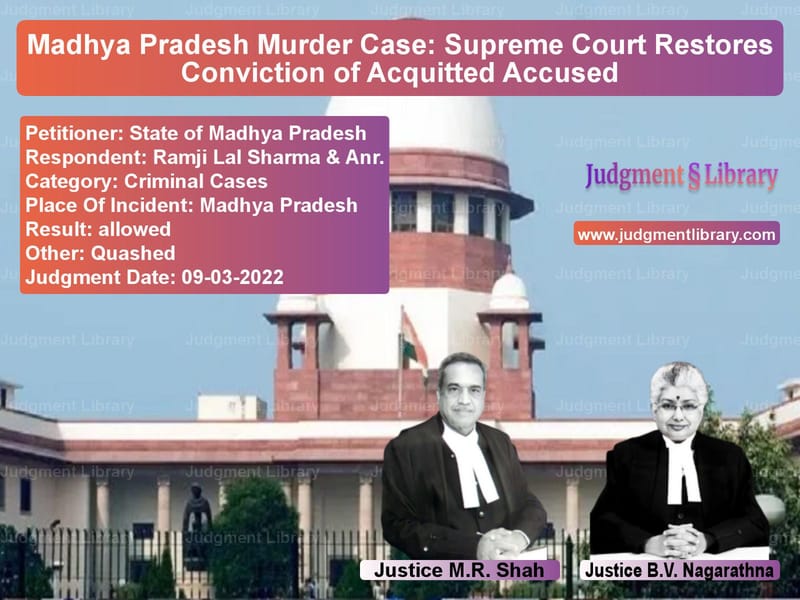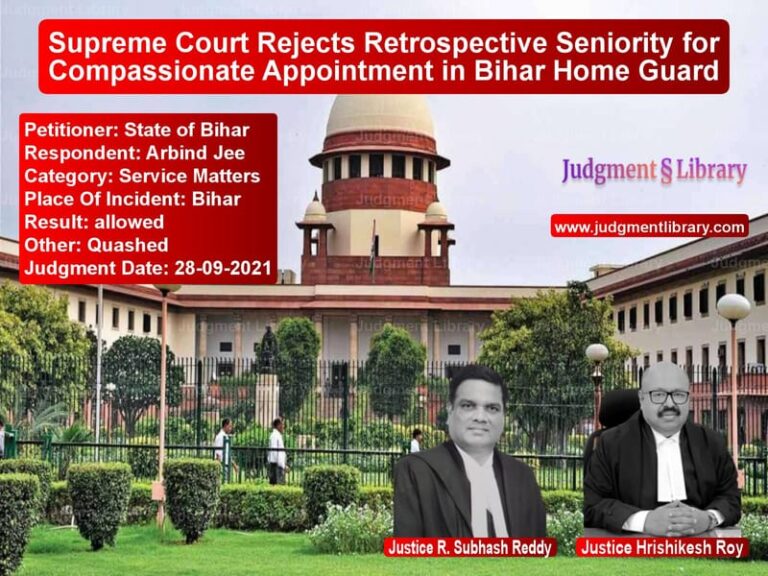Madhya Pradesh Murder Case: Supreme Court Restores Conviction of Acquitted Accused
The case of State of Madhya Pradesh vs. Ramji Lal Sharma & Anr. involves a brutal murder in Madhya Pradesh, where the accused were initially convicted by the Trial Court but later acquitted by the High Court on the grounds of benefit of doubt. The Supreme Court overturned the acquittal, reinstating the conviction and sentencing of the accused under Section 302 read with Section 34 of the IPC.
Background of the Case
The case traces back to an incident that occurred on January 17, 2002. The prosecution alleged that a dispute over money led to the accused Ramji Lal Sharma and Brajmohan (Kallu) attacking the victim, Munshilal, with firearms and an axe. According to the prosecution, the attack was premeditated, and the accused had a common intention to kill the victim.
The Trial Court found all accused guilty and sentenced them to life imprisonment under Section 302 read with Section 34 of the IPC. However, upon appeal, the High Court of Madhya Pradesh acquitted Ramji Lal Sharma and Brajmohan, granting them the benefit of the doubt, while convicting the remaining accused.
The State of Madhya Pradesh challenged this acquittal before the Supreme Court.
Arguments of the Petitioner (State of Madhya Pradesh)
The prosecution, represented by Additional Advocate General Prashant Singh, argued:
- The High Court erred in giving the accused benefit of doubt based on minor inconsistencies between the medical and ocular evidence.
- The accused were present at the scene and actively participated in the attack, proving their common intention.
- The Trial Court had rightly convicted all accused based on the eyewitness testimonies of PW1, PW3, and PW5.
- The FIR and the statements of the eyewitnesses clearly established the accused’s role in the crime.
Arguments of the Respondents (Ramji Lal Sharma & Brajmohan)
The defense, represented by Senior Counsel R.K. Sinha, countered:
- The High Court correctly found inconsistencies between medical evidence and eyewitness testimonies.
- The prosecution failed to establish the exact role of Ramji Lal Sharma and Brajmohan in the crime.
- Benefit of doubt must be given when evidence is inconclusive, as held in previous Supreme Court judgments.
Supreme Court’s Observations
The Supreme Court, comprising Justices M.R. Shah and B.V. Nagarathna, analyzed the evidence and found that:
- The High Court had erred in disregarding the prosecution’s ocular evidence (eyewitness testimony) merely due to minor discrepancies in medical reports.
- Testimonies of PW1, PW3, and PW5 were consistent and clearly established the presence of the accused at the crime scene.
- The High Court had failed to consider the concept of common intention under Section 34 IPC, which holds all participants of a crime equally liable.
- The Trial Court’s findings were sound, and there was no justification for overturning the conviction.
The Court emphasized:
“Once it has been established that all the accused came to the place of the incident with a common intention to kill the deceased, it is immaterial whether any of them actually inflicted the fatal blow.”
Supreme Court’s Verdict
On March 9, 2022, the Supreme Court ruled:
- The High Court’s acquittal of Ramji Lal Sharma and Brajmohan was quashed.
- Their conviction under Section 302 read with Section 34 IPC was restored.
- They were sentenced to life imprisonment, as originally ruled by the Trial Court.
- The accused were directed to surrender within four weeks to serve the remaining sentence.
The Court concluded:
“The presence of all the accused has been established, and the prosecution has successfully proved that all the accused shared a common intention to commit the murder.”
Conclusion
This ruling clarifies important legal principles:
- Common intention under Section 34 IPC: Even if an accused does not personally inflict injuries, they can be held liable if they share a common intention with the attackers.
- Ocular evidence prevails over minor inconsistencies: When multiple eyewitnesses consistently identify the accused, minor medical discrepancies do not justify acquittal.
- Acquittals must be based on sound legal reasoning: The High Court’s decision was set aside because it failed to properly evaluate the evidence.
This ruling reaffirms the importance of a thorough examination of all evidence and ensures that justice is served in cases of violent crimes.
Petitioner Name: State of Madhya Pradesh.Respondent Name: Ramji Lal Sharma & Anr..Judgment By: Justice M.R. Shah, Justice B.V. Nagarathna.Place Of Incident: Madhya Pradesh.Judgment Date: 09-03-2022.
Don’t miss out on the full details! Download the complete judgment in PDF format below and gain valuable insights instantly!
Download Judgment: state-of-madhya-prad-vs-ramji-lal-sharma-&-a-supreme-court-of-india-judgment-dated-09-03-2022.pdf
Directly Download Judgment: Directly download this Judgment
See all petitions in Murder Cases
See all petitions in Bail and Anticipatory Bail
See all petitions in SC/ST Act Case
See all petitions in Judgment by Mukeshkumar Rasikbhai Shah
See all petitions in Judgment by B.V. Nagarathna
See all petitions in allowed
See all petitions in Quashed
See all petitions in supreme court of India judgments March 2022
See all petitions in 2022 judgments
See all posts in Criminal Cases Category
See all allowed petitions in Criminal Cases Category
See all Dismissed petitions in Criminal Cases Category
See all partially allowed petitions in Criminal Cases Category







